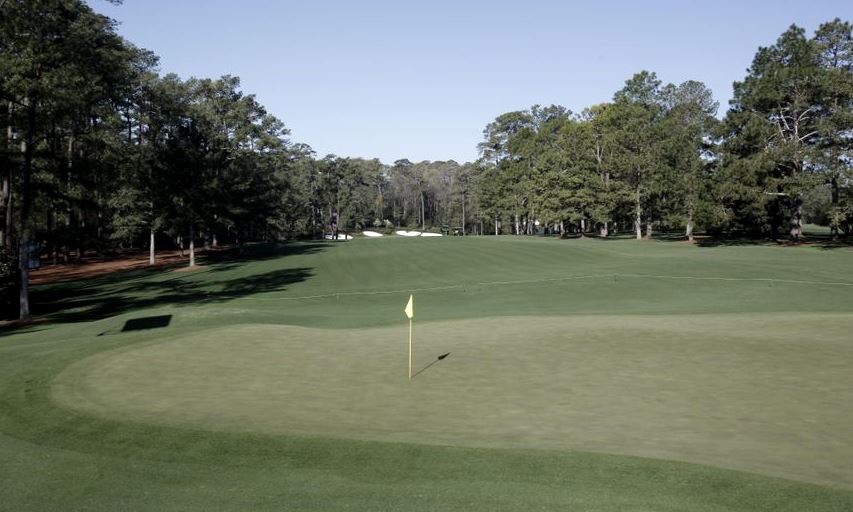No Bunkers Doesn’t Mean No Problems On 14th At Augusta
- Details
- Category: Inside Golf
- Published: 2018-04-02

This Photo Shows The Green On The 14th Hole At Augusta National Golf Club, The Site Of The 2010 Masters. The Hole Can Be A Pivotal Part Of A Sunday Charge At The Masters. (AP Photo/Rob Carr, File)
AUGUSTA, Georgia (Doug Ferguson/AP) — Phil Mickelson was 148 yards away in the middle of the 14th fairway at Augusta National and saw a pin that was set up for birdies.
The trick was getting there.
He wanted to flight a low 9-iron so it would carry over the first tier and land about four paces short of the hole. His caddie, Jim “Bones” Mackay, wanted him to take something off a pitching wedge, and Lefty concurred. It landed about 12 feet short, rode the slope and came within inches of going in.
It wasn’t his most famous birdie in 2004, when Mickelson won his first Masters, but it was no less important.
What allows it to get overlooked is its position on the dynamic back nine, right between the two par 5s.
“I think it’s as exciting a hole as any,” Jordan Spieth said.
Spieth had his own adventures there when he won the Masters in 2015. He was in the trees to the right of the 14th green when he slashed at a 7-iron and feared it would run through the green and into all sorts of trouble. Instead, it smacked the pin and settled a few feet away for birdie.
The 14th hole — effectively the halfway point of any back-nine charge at Augusta National — is known as Chinese Fir. It originally was called Spanish Dagger, though it was anything but that for Sergio Garcia last year. He smartly played the slope for a short birdie putt in the final round to pull within one shot of the lead.
Mickelson also left his mark there in 2010 by holing out for his second straight eagle. Horton Smith might have had the best birdie of all, chipping in from 50 feet when he won the Masters in 1936.
More than any sensational shot, however, the 440-yard hole is best known for what it doesn’t have: a bunker.
It is the only hole at Augusta National without a bunker, though that wasn’t always the case. There used to be a large bunker down the right side, except that it was so close to the tee that it never came into play. It was eliminated in 1952.
Besides, this hole is all about the green.
The large putting surface has huge contours that fall like terraces toward the front from left to right. That’s one reason that for two pin positions over the front tier, Justin Rose doesn’t really pay attention to the pin.
“If you hit straight at them, the ball will release 40 feet to the right,” Rose said. “In my yardage book, I have that you have to aim 5 yards left to hit it right. The pin is not the pin. So I have one pin 5 yards left, and one pin 8 yards left. It’s a very clever green.”
The biggest concern is a left pin, because it helps to land on the left side of the pin, but missing the pin to the left is near impossible. Rory McIlroy recalls doing that one year. “It was the only year I missed the cut,” he said.
“It’s all about the second shot and getting it to the right level,” McIlroy said. “The difference of a yard on the other side of the slope is the difference of a 40-footer and being stone dead. I used to look at it on TV and say: ‘This is easy. People hit it in the middle and it feeds to the hole.’
“Then you play the hole,” he said, “and there’s a 3-yard square you have to hit it on any pin position.”
Louis Oosthuizen is among those who realize a hole like the 14th doesn’t need bunkers or a water hazard to be a great hole. He also was among the few who got away with a mistake when he left it short of the massive tier at the front of the green. It was 2012, when the South African was battling Bubba Watson on the back nine.
“It’s not a pin I even think about getting close,” he said. “I ended up going for it because I had a good distance, a good, solid wedge. I thought I could pitch it two yards short of the pin, and I just hit slightly thin. It pitched on the upslope and came all the way back. I hit the best bump-and-run 9-iron into the slope to 6 feet and made par.”
Garcia didn’t have a choice, and it paid off.
Ditto for Mickelson in 2004, especially after he heard the roars for Ernie Els making birdie on the 15th ahead of him for a two-shot lead.
But it can go either way with the slightest miss.
“You know 13 is a birdie hole. You know 15 is a birdie hole, and on Sunday, you know 16 can be a birdie hole,” Rose said. “It’s a fun run at Augusta. Fourteen is one of those holes that offers a birdie opportunity, but par is good. It’s the one hole you’ve got to respect, especially if you get out of position.”



